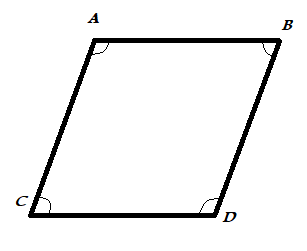
Sum of all interior angles of a parallelogram is
a) \[{180^\circ }\]
b) \[{360^\circ }\]
c) \[{540^\circ }\]
d) \[{240^\circ }\]
Answer
510.6k+ views
Hint: A parallelogram is a polygon having four sides. Since we know that all interior angles on the same side of the transversal are supplementary. We can use this property to get the sum of all the interior angles of a parallelogram. Same way we can use a formula given as \[\left( {n - 2} \right) \times {180^\circ }\]. With the help of the given formula we can find the sum of all interior angles of any polygon.
Formula used: Sum of all interior angles of a polygon is given as \[\left( {n - 2} \right) \times {180^\circ }\]. Here \[n\] is the number of sides a polygon has.
Complete step-by-step solution:
Here we are required to find the sum of all interior angles of a parallelogram. We are going to find by using both the formula of sum of all interior angles of polygon and supplementary angles property.
By formula method, we know that the sum of all interior angles of a polygon is given as \[\left( {n - 2} \right) \times {180^\circ }\]. Here \[n\] is the number of sides a polygon has.
Now we know that a parallelogram is a polygon having four sides, so here \[n = 4\]. Putting this in \[\left( {n - 2} \right) \times {180^\circ }\].
\[
\Rightarrow \left( {4 - 2} \right) \times {180^\circ } \\
\Rightarrow 2 \times {180^\circ } \\
\Rightarrow {360^\circ } \]
So, the sum of all interior angles of a parallelogram is \[{360^\circ }\].
Now, using supplementary angles property,
We know that all interior angles on the same side of the transversal are supplementary.

So, \[\angle A + \angle B = {180^\circ }\] and \[\angle C + \angle D = {180^\circ }\].
Now we take sum of all the angles,
\[\angle A + \angle B + \angle C + \angle D = {180^\circ } + {180^\circ }\]
\[ \Rightarrow \angle A + \angle B + \angle C + \angle D = {360^\circ }\]
So by this method also, we get to sum all interior angles of a parallelogram as \[{360^\circ }\].
Hence the answer is b) \[{360^\circ }\].
Note: It is to note that the sum of all interior angles of a polygon of four sides is \[{360^\circ }\] whether it is a square, rectangle, kite, trapezium etc. In the same way, using \[\left( {n - 2} \right) \times {180^\circ }\] we can find the sum of all the interior angles of any polygon having any number of sides. For ex. for a pentagon the sum of all the interior angles is \[\left( {5 - 2} \right) \times {180^\circ } = {540^\circ }\].
Formula used: Sum of all interior angles of a polygon is given as \[\left( {n - 2} \right) \times {180^\circ }\]. Here \[n\] is the number of sides a polygon has.
Complete step-by-step solution:
Here we are required to find the sum of all interior angles of a parallelogram. We are going to find by using both the formula of sum of all interior angles of polygon and supplementary angles property.
By formula method, we know that the sum of all interior angles of a polygon is given as \[\left( {n - 2} \right) \times {180^\circ }\]. Here \[n\] is the number of sides a polygon has.
Now we know that a parallelogram is a polygon having four sides, so here \[n = 4\]. Putting this in \[\left( {n - 2} \right) \times {180^\circ }\].
\[
\Rightarrow \left( {4 - 2} \right) \times {180^\circ } \\
\Rightarrow 2 \times {180^\circ } \\
\Rightarrow {360^\circ } \]
So, the sum of all interior angles of a parallelogram is \[{360^\circ }\].
Now, using supplementary angles property,
We know that all interior angles on the same side of the transversal are supplementary.

So, \[\angle A + \angle B = {180^\circ }\] and \[\angle C + \angle D = {180^\circ }\].
Now we take sum of all the angles,
\[\angle A + \angle B + \angle C + \angle D = {180^\circ } + {180^\circ }\]
\[ \Rightarrow \angle A + \angle B + \angle C + \angle D = {360^\circ }\]
So by this method also, we get to sum all interior angles of a parallelogram as \[{360^\circ }\].
Hence the answer is b) \[{360^\circ }\].
Note: It is to note that the sum of all interior angles of a polygon of four sides is \[{360^\circ }\] whether it is a square, rectangle, kite, trapezium etc. In the same way, using \[\left( {n - 2} \right) \times {180^\circ }\] we can find the sum of all the interior angles of any polygon having any number of sides. For ex. for a pentagon the sum of all the interior angles is \[\left( {5 - 2} \right) \times {180^\circ } = {540^\circ }\].
Recently Updated Pages
Master Class 12 Business Studies: Engaging Questions & Answers for Success

Master Class 12 Economics: Engaging Questions & Answers for Success

Master Class 12 English: Engaging Questions & Answers for Success

Master Class 12 Maths: Engaging Questions & Answers for Success

Master Class 12 Social Science: Engaging Questions & Answers for Success

Master Class 12 Chemistry: Engaging Questions & Answers for Success

Trending doubts
What is BLO What is the full form of BLO class 8 social science CBSE

Which places in India experience sunrise first and class 9 social science CBSE

The shortest day of the year in India

What are the major means of transport Explain each class 12 social science CBSE

Which are the Top 10 Largest Countries of the World?

How many millions make a billion class 6 maths CBSE




